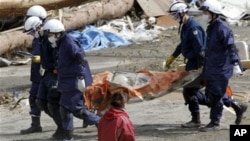As Japan's makeshift morgues fill to capacity with earthquake and tsunami victims, families are being forced to forgo the Japanese tradition of cremating the bodies of their loved ones.
Japanese soldiers helped to lower wood coffins into a mass grave in a northeastern town, Higashi Matsushima, as relatives looked on and said their final goodbyes this week. Kyodo news agency says 24 bodies were interred at the site Tuesday, and the local government is prepared to bury up to 1,000.
All the remains placed in the mass grave so far have been identified, and coffins marked, so families can provide a more traditional Buddhist funeral at a later time. That involves a wake ceremony before cremation. Relatives then use chopsticks to transfer the ashes to an urn, which is displayed for a period of time and then buried.
Japan's crematories have been overwhelmed as the bodies of more and more victims of the March 11 earthquake and tsunami disaster are recovered. A kerosene shortage has made matters worse, since that fuel normally powers crematories.
Schools, gymnasiums and at least one bowling alley have been turned into emergency morgues to hold the growing number of dead. A shortage of dry ice used to preserve the bodies is adding urgency to an already grim and desperate situation.
With more than 15,000 people still unaccounted for, Japan's struggle with how to lay the dead to rest likely will continue for some time.
Some information for this report was provided by AFP and Reuters.










